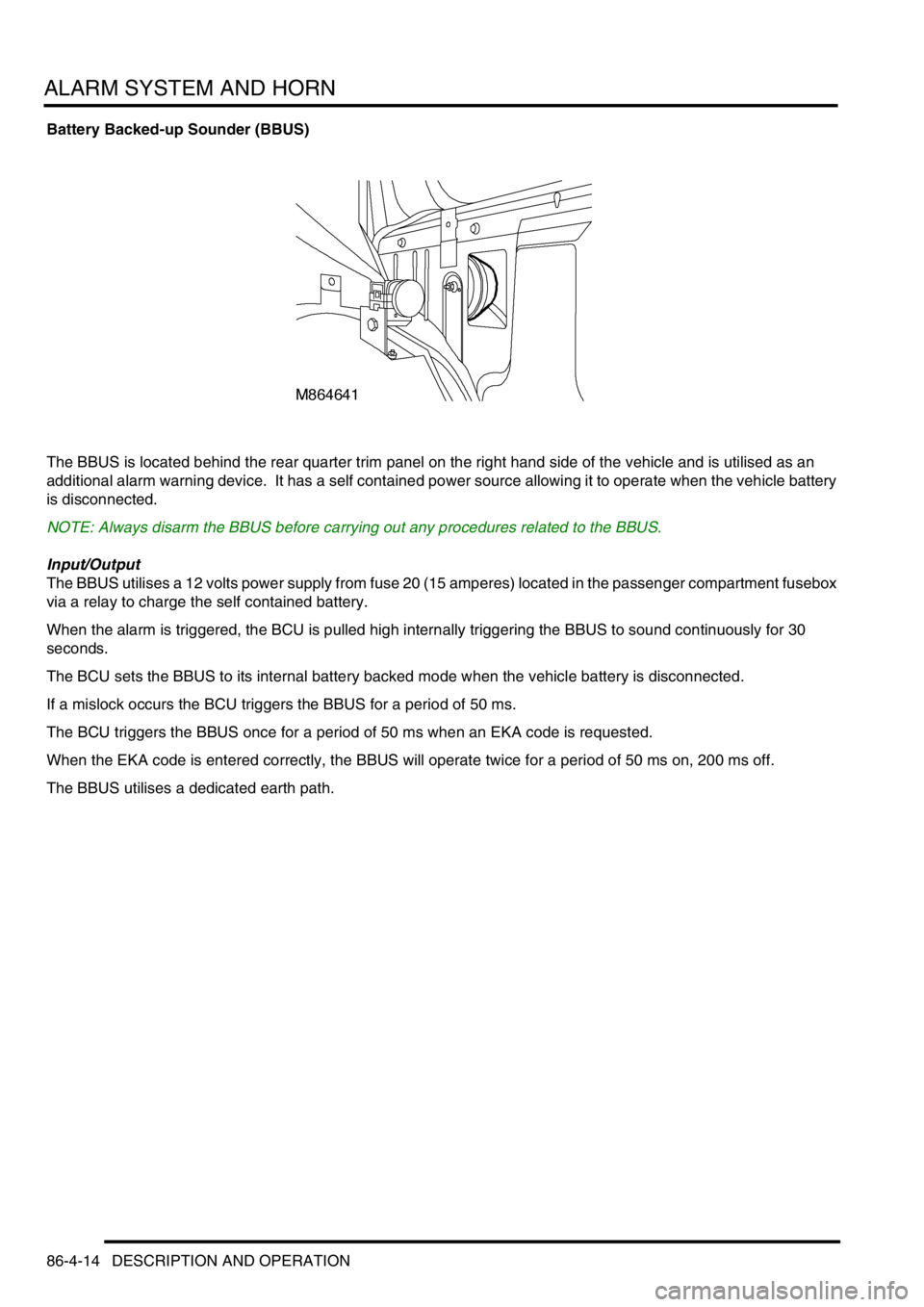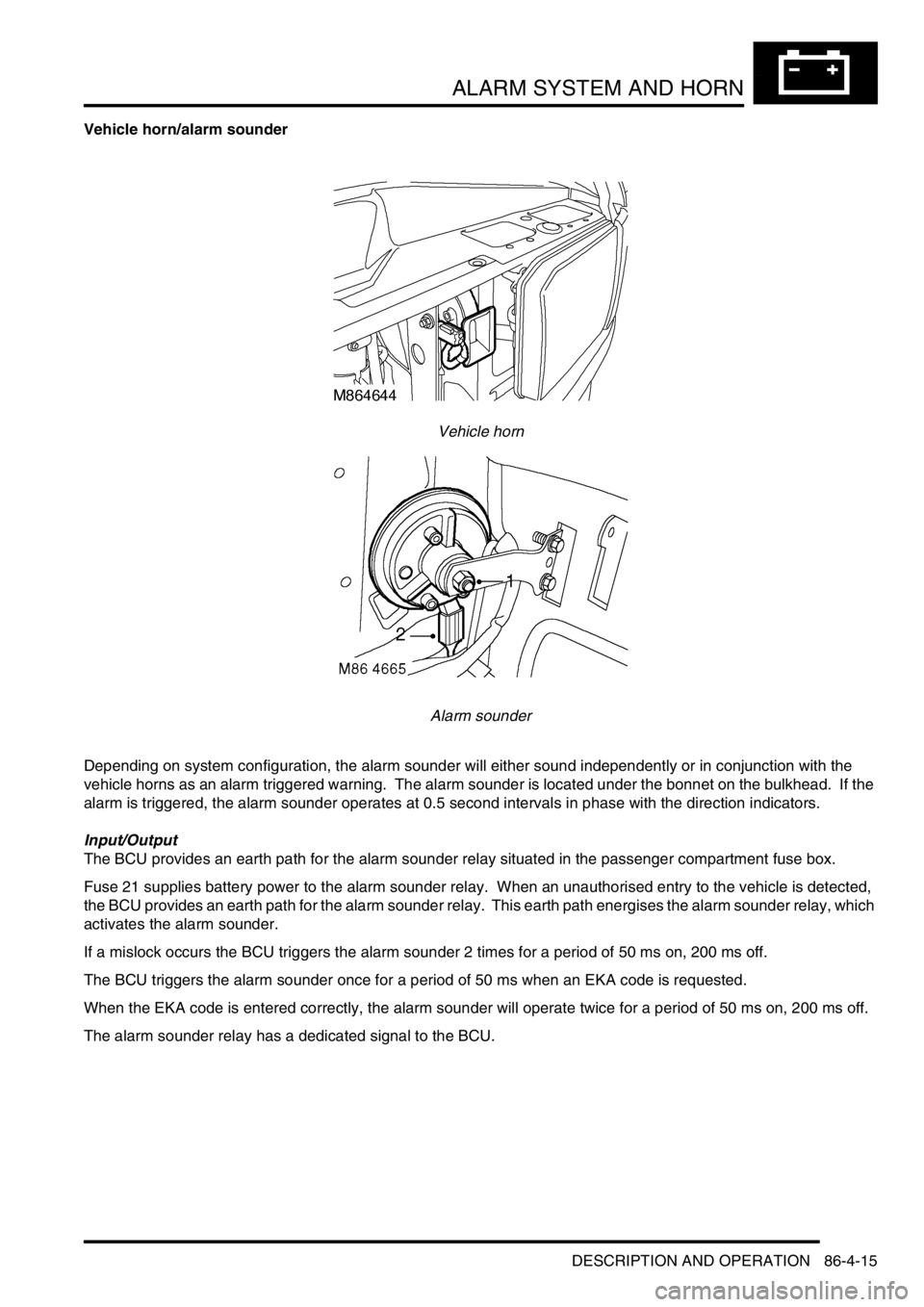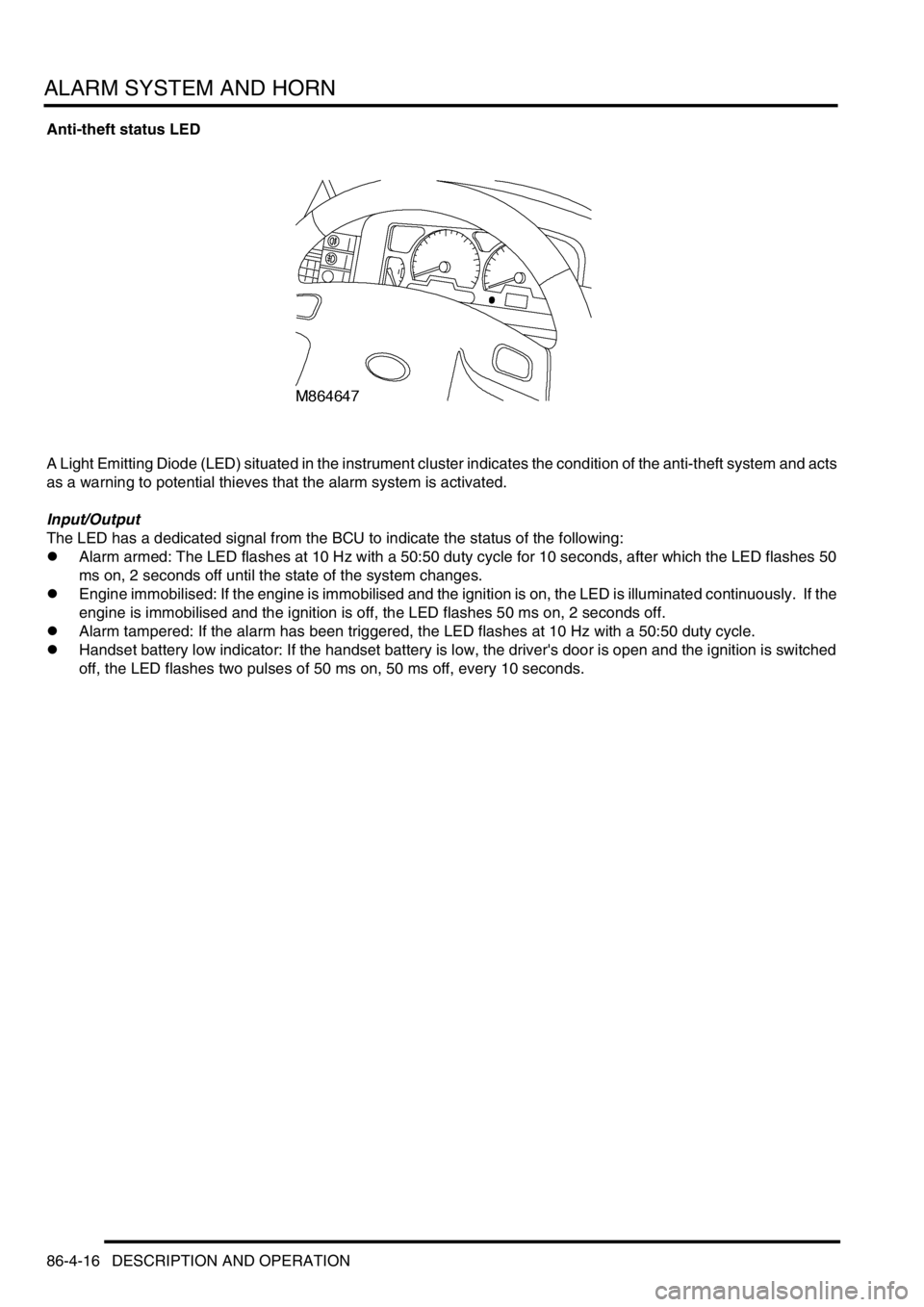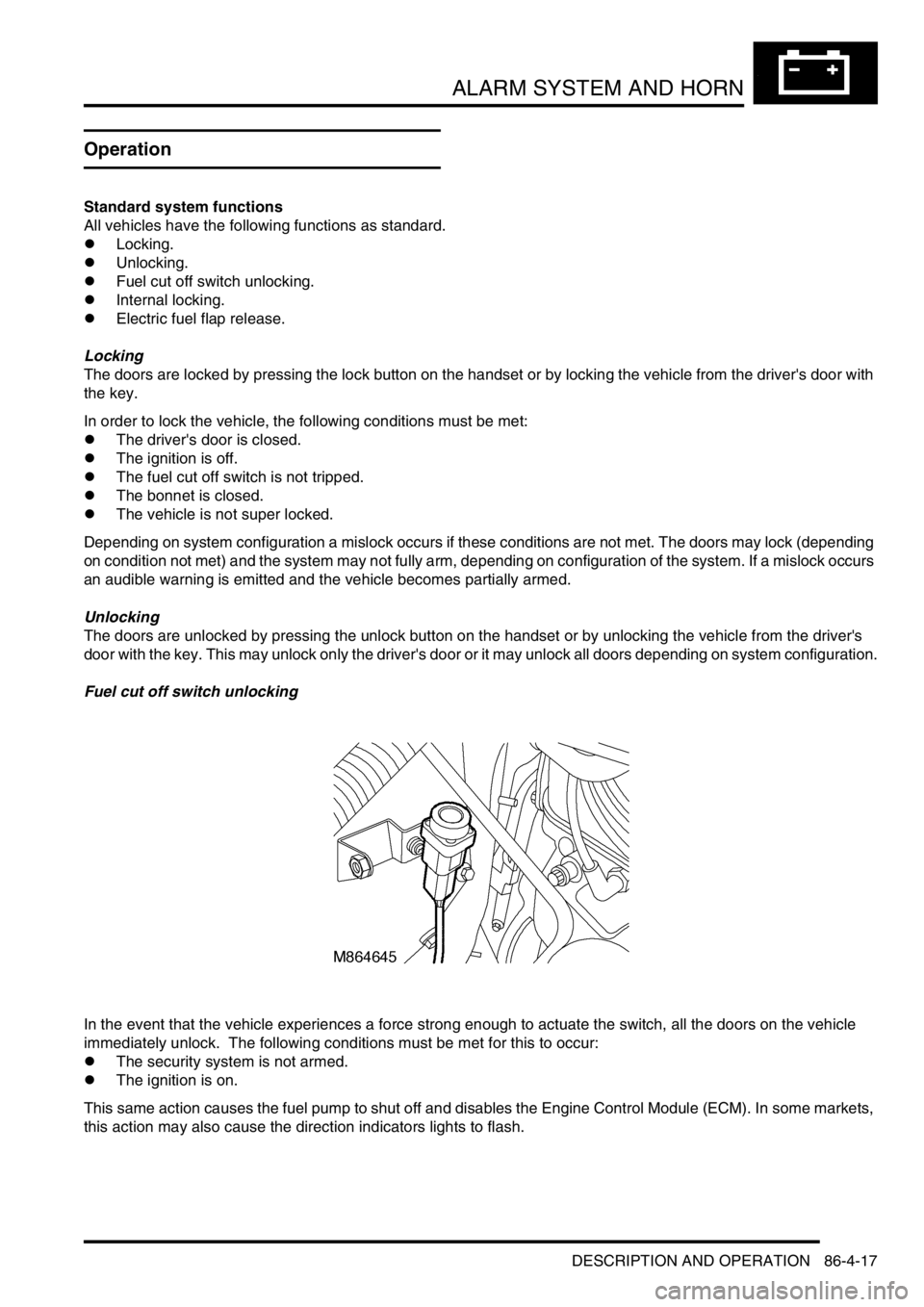1999 LAND ROVER DISCOVERY warning
[x] Cancel search: warningPage 1315 of 1529

BODY CONTROL UNIT
86-3-28 DESCRIPTION AND OPERATION
Courtesy headlamps
This feature activates the headlamps for 30 seconds when the lock button on the remote transmitter is held down for
longer than 1 second. The headlamps will extinguish if the BCU receives either a lock or an unlock signal from the
remote transmitter.
The BCU checks the status of the following inputs to determine the correct qualifying conditions for requesting
courtesy headlamps:
lIgnition state.
lRemote locking request.
lRemote unlocking request.
lLazy locking request.
If the ignition is off and a lazy locking request is received, the courtesy headlamps are switched on and an internal
timer is turned on in the BCU which operates for 30 seconds. If the 30 second timer expires or a request for remote
locking or remote unlocking is received, the courtesy headlamps will be turned off.
When main beam is selected, the IDM also provides a signal to the instrument pack to switch on the main beam
warning lamp. An additional signal 'main beam indicator disable' is used to prevent the daylight running lamps
illuminating the main beam indicator when the main beam is in the daylight running lamp state and the main beam
indicator disable signal is on.
Lights on alarm
The lights on alarm in the instrument pack operates when the driver's door is open and the side lamps or headlamps
are on. The system uses inputs from the driver's door switch and the lighting switch to determine the logical conditions
that need to occur for switching on the alarm. The BCU carries out the logic operation and communicates with the
instrument pack using the serial data bus; the instrument pack will be requested to sound the alarm if the logic inputs
indicate that the driver's door is open with the lights still on.
Supply voltage is provided through the lighting switch to the IDM which acts as the signal line to indicate that the lights
are on for the logic circuits in the IDM and BCU. When the driver's door is opened, a second feed is supplied to the
BCU through the driver's door switch to indicate the condition. In this logic condition (lights on and driver's door open)
the BCU signals the instrument pack to operate the audible warning. If the lights are switched off or the driver's door
is closed the logic condition will be changed and the audible warning will be switched off.
Daylight running lamps
The BCU operates the daylight running lamps (where fitted) via the IDM. The daylight running lamps option can be
programmed in one of three states dependent on market/ customer requirements, these are:
lOption 1– no daylight running lamps.
lOption 2 – on with main beam off.
lOption 3 – on with main and dipped beam off and gearbox not in Park.
The BCU will ensure the logical conditions are satisfied for the lamps to operate under the set conditions. The BCU
checks the status of the following inputs to determine the logic action for providing an output to the daylight running
lamp relay:
lMain beam state.
lEngine running (link from instrument pack).
lDipped beam.
lGearbox state.
A voltage supply is fed to the coil of the daylight running lamp relay and the IDM. When the preconditions are satisfied
for daylight running lamp operation, the BCU sends a signal for the IDM to complete the circuit to earth to switch on
the daylight running lamps. The logical inputs are checked to ensure that the engine is running before switching the
relay to turn on the daylight running lamps. The engine running signal has to be present for at least 2 seconds before
the daylight running lamp relay can be switched on.
Fog lamps
The BCU operates the rear fog lamps and the front fog lamps (where fitted) via the IDM. The BCU front fog lamp
operation can be programmed to operate under one of three set conditions. The BCU will ensure the logical conditions
are satisfied for the lamps to operate under the set conditions.
Page 1317 of 1529

BODY CONTROL UNIT
86-3-30 DESCRIPTION AND OPERATION
Interior courtesy lamps
To determine when to provide an interior courtesy lamps enable output, the BCU checks the following input
conditions:
lIgnition state.
lTransit mode.
lDriver's door open.
lPassenger or rear door open.
The courtesy lamps operate at full brightness when they are first switched on. The BCU then gradually dims the lamps
(fade-out) before completely switching them off. Fade-out occurs over a period of two seconds following the logical
control signal to turn off the lights. When a door is opened, the BCU provides earth paths from the interior lamps, the
load space lamp and the ignition switch illumination. The following table lists the courtesy lamps operation and
duration for holding the lamps on that occurs after the BCU has detected a condition that signals the courtesy lamps
should be switched on:
Instrument pack
The BCU communicates with the instrument pack to provide a range of functions.
Odometer update
The BCU can be programmed for one of two options:
lOption 1 – no odometer error warning.
lOption 2 – odometer error warning.
In order to provide an LCD flash request to the instrument pack via the communications link, the following inputs are
checked:
lIgnition state.
lInstrument pack odometer value (via the communications link).
lBCU odometer value.
The function is only active when the ignition state is on. The maximum allowed value is 999,999 miles (1,608,999
km).If the instrument pack odometer value is greater than the maximum allowed value, the maximum value is
assumed. The BCU odometer value is stored in EEPROM. If 16 identical values of the instrument pack odometer
reading is received consecutively, the instrument pack odometer value is compared with the BCU odometer value. If
the consecutive readings from the instrument pack differ, the BCU odometer value is incremented accordingly. If the
BCU odometer value is less than the instrument pack odometer value by up to 10 km, the BCU odometer value is set
equal to the instrument pack odometer value.
If the odometer warning option is enabled, and the contents of the instrument pack odometer value buffer is identical
to, or greater than BCU odometer value ± 10 km, the BCU sends an LED flash request to the instrument pack.
In the event of a communications link failure, this function will be unable to operate.
Control signal Additional conditions Duration
Door open - 10 minutes
Unlock signal from remote transmitter All doors closed and ignition switch not in
position III1 minute
Unlock signal from the driver's door lock All doors closed and ignition switch not in
position III1 minute
Ignition switch turned from position II or III to
position 0All doors closed 1 minute
Door changed from open to closed All other doors closed and ignition switch not
in position III15 seconds
Ignition switch in position III - Timer cancelled
BCU receives a lock command - Timer cancelled
Vehicle has transit mode enabled - 15 seconds on all occasions
Page 1320 of 1529

BODY CONTROL UNIT
DESCRIPTION AND OPERATION 86-3-33
In the event of a communications link failure occurring while the transfer box enable is on, the output will be switched
off.
Gear position switch
On automatic gearbox models, the BCU provides an output which supplies power to the automatic gearbox gear
position switch. The BCU checks for the following inputs before it supplies power:
lIgnition on.
lAuxiliary.
When the ignition is on, the feed to the gear position switch is on. When the ignition is off and auxiliary is off for more
than 30 seconds, feed to the gear position switch is off.
+ AUTOMATIC GEARBOX - ZF4HP22 - 24, DESCRIPTION AND OPERATION, Description.
Fuel flap release
The fuel flap release solenoid only operates when the ignition switch is switched off, the anti-theft system is not
activated and the fuel flap release switch is pressed. If the BCU detects that these conditions have been satisfied, it
provides a path to earth for the fuel flap solenoid, so allowing the fuel flap to be opened.
To decide the correct conditions for providing a fuel flap enable output, the BCU checks the following input conditions:
lIgnition state.
lPerimetric alarm state.
If the battery state is not normal, the electric fuel flap enable is switched off.
Audible warnings
The BCU can request the instrument pack to generate an audible warning in response to logic conditions which have
been detected by the BCU and which need to be drawn to the driver's attention.
+ INSTRUMENTS, DESCRIPTION AND OPERATION, Description.
Seat belt warning
The BCU can be programmed to include seat belt warning using one of four options:
lOption 1 – warning on for 6 seconds.
lOption 2 – warning on for 6 seconds or until the seat belt is fastened.
lOption 3 – warning on for 6 seconds unless the seat belt is fastened.
lOption 4 – no warning.
The BCU checks the status of the following inputs:
lIgnition on.
lSeat belt fastened.
Depending on the logic conditions of the inputs, the BCU provides the following outputs:
lAudible warning No.1 requested.
lSeat belt not fastened warning on instrument pack (via datalink to the instrument pack).
When programmed for option 1 operation, audible warning No. 1 is requested when the ignition switch is turned from
off to position II. The audible warning remains active for 6 seconds and a warning lamp on the instrument pack is
illuminated for the same duration.
When programmed for option 2 operation, audible warning No. 1 is requested when the ignition switch is turned from
off to position II. The audible warning remains active for 6 seconds or until the seat belt fastened signal is on and a
warning lamp on the instrument pack is illuminated for the same duration.
When programmed for option 3 operation, audible warning No. 1 is requested when the ignition switch is turned from
off to position II. The audible warning remains active for 6 seconds if the seat belt fastened signal is off; a warning
lamp on the instrument pack is illuminated for the same duration.
In the event of a communications link failure occurring, the audible and visual warning requests are not sent to the
instrument pack.
Page 1321 of 1529

BODY CONTROL UNIT
86-3-34 DESCRIPTION AND OPERATION
Key-in warning
The BCU can be programmed to one of two options:
lOption 1 – no timeout.
lOption 2 – no key-in warning.
The BCU issues an audible warning No. 2 request, depending on the status of the following inputs:
lIgnition state.
lIgnition key inserted.
lDriver's door open.
If the key-in warning is programmed into the BCU for operation, audible warning No.2 will be requested if the ignition
switch is off, the ignition key inserted signal is on and the driver's door open signal is ON.
In the event of a communications link failure occurring, the audible warning request is not sent to the instrument pack.
SLABS HDC warning
The BCU issues an audible warning No. 3 request, depending on the status of the following inputs:
lIgnition state.
lSLABS HDC warning.
The SLABS warning transmitted by the SLABS ECU is a 2 Hz signal, audible warning No. 3 is requested on every
falling edge of this signal. If the signal from the SLABS ECU stays low for more than 650 ms, audible warning No. 3
is requested every 2 seconds, for 30 seconds, while the signal stays low.
In the event of a communications link failure occurring, the audible warning request is not sent to the instrument pack.
Transfer box in neutral warning
If the transfer box is in the neutral position and the ignition switch is on, the BCU issues an audible warning No. 4
request. The BCU checks for the following inputs:
lTransfer box neutral selected.
lIgnition on.
The transfer box in neutral warning is activated by communicating with the instrument pack via the serial datalink. If
a communications link failure occurs while the transfer box in neutral warning is active, the audible warning will not
operate.
Lights on warning
If the ignition switch is off while the side lamps or headlamps on and the driver's door is opened, the BCU issues an
audible warning No. 5 request.
The BCU checks for the following inputs:
lDriver's door open.
lIgnition on.
lSide lamps.
lDipped beam state.
lMain beam state.
The lights on warning is activated by communicating with the instrument pack via the serial datalink. If a
communications link failure occurs while the lights on warning is active, the audible warning will not operate.
SLABS raise/lower
Before enabling a SLS vehicle raise/ lower request, the BCU checks the logical condition of the following inputs:
lIgnition state.
lSLABS raise request.
lSLABS lower request.
If the ignition switch is in position 0 or I, the vehicle raise/ lower request is off.
With the ignition switch in position II, and the 'SLABS raise' request and 'SLABS lower' request both off, the vehicle
raise/ lower request output is driven at 25 Hz with a 50% duty cycle and the vehicle height remains unchanged.
If the 'SLABS lower' request input is on, the vehicle raise/lower request output is driven at 25 Hz with a 25% duty cycle,
lowering the vehicle.
If the 'SLABS raise' request input is on, the vehicle raise/lower request output is driven at a 25 Hz with a 75% duty
cycle.
Page 1337 of 1529

ALARM SYSTEM AND HORN
86-4-14 DESCRIPTION AND OPERATION
Battery Backed-up Sounder (BBUS)
The BBUS is located behind the rear quarter trim panel on the right hand side of the vehicle and is utilised as an
additional alarm warning device. It has a self contained power source allowing it to operate when the vehicle battery
is disconnected.
NOTE: Always disarm the BBUS before carrying out any procedures related to the BBUS.
Input/Output
The BBUS utilises a 12 volts power supply from fuse 20 (15 amperes) located in the passenger compartment fusebox
via a relay to charge the self contained battery.
When the alarm is triggered, the BCU is pulled high internally triggering the BBUS to sound continuously for 30
seconds.
The BCU sets the BBUS to its internal battery backed mode when the vehicle battery is disconnected.
If a mislock occurs the BCU triggers the BBUS for a period of 50 ms.
The BCU triggers the BBUS once for a period of 50 ms when an EKA code is requested.
When the EKA code is entered correctly, the BBUS will operate twice for a period of 50 ms on, 200 ms off.
The BBUS utilises a dedicated earth path.
Page 1338 of 1529

ALARM SYSTEM AND HORN
DESCRIPTION AND OPERATION 86-4-15
Vehicle horn/alarm sounder
Vehicle horn
Alarm sounder
Depending on system configuration, the alarm sounder will either sound independently or in conjunction with the
vehicle horns as an alarm triggered warning. The alarm sounder is located under the bonnet on the bulkhead. If the
alarm is triggered, the alarm sounder operates at 0.5 second intervals in phase with the direction indicators.
Input/Output
The BCU provides an earth path for the alarm sounder relay situated in the passenger compartment fuse box.
Fuse 21 supplies battery power to the alarm sounder relay. When an unauthorised entry to the vehicle is detected,
the BCU provides an earth path for the alarm sounder relay. This earth path energises the alarm sounder relay, which
activates the alarm sounder.
If a mislock occurs the BCU triggers the alarm sounder 2 times for a period of 50 ms on, 200 ms off.
The BCU triggers the alarm sounder once for a period of 50 ms when an EKA code is requested.
When the EKA code is entered correctly, the alarm sounder will operate twice for a period of 50 ms on, 200 ms off.
The alarm sounder relay has a dedicated signal to the BCU.
Page 1339 of 1529

ALARM SYSTEM AND HORN
86-4-16 DESCRIPTION AND OPERATION
Anti-theft status LED
A Light Emitting Diode (LED) situated in the instrument cluster indicates the condition of the anti-theft system and acts
as a warning to potential thieves that the alarm system is activated.
Input/Output
The LED has a dedicated signal from the BCU to indicate the status of the following:
lAlarm armed: The LED flashes at 10 Hz with a 50:50 duty cycle for 10 seconds, after which the LED flashes 50
ms on, 2 seconds off until the state of the system changes.
lEngine immobilised: If the engine is immobilised and the ignition is on, the LED is illuminated continuously. If the
engine is immobilised and the ignition is off, the LED flashes 50 ms on, 2 seconds off.
lAlarm tampered: If the alarm has been triggered, the LED flashes at 10 Hz with a 50:50 duty cycle.
lHandset battery low indicator: If the handset battery is low, the driver's door is open and the ignition is switched
off, the LED flashes two pulses of 50 ms on, 50 ms off, every 10 seconds.
Page 1340 of 1529

ALARM SYSTEM AND HORN
DESCRIPTION AND OPERATION 86-4-17
Operation
Standard system functions
All vehicles have the following functions as standard.
lLocking.
lUnlocking.
lFuel cut off switch unlocking.
lInternal locking.
lElectric fuel flap release.
Locking
The doors are locked by pressing the lock button on the handset or by locking the vehicle from the driver's door with
the key.
In order to lock the vehicle, the following conditions must be met:
lThe driver's door is closed.
lThe ignition is off.
lThe fuel cut off switch is not tripped.
lThe bonnet is closed.
lThe vehicle is not super locked.
Depending on system configuration a mislock occurs if these conditions are not met. The doors may lock (depending
on condition not met) and the system may not fully arm, depending on configuration of the system. If a mislock occurs
an audible warning is emitted and the vehicle becomes partially armed.
Unlocking
The doors are unlocked by pressing the unlock button on the handset or by unlocking the vehicle from the driver's
door with the key. This may unlock only the driver's door or it may unlock all doors depending on system configuration.
Fuel cut off switch unlocking
In the event that the vehicle experiences a force strong enough to actuate the switch, all the doors on the vehicle
immediately unlock. The following conditions must be met for this to occur:
lThe security system is not armed.
lThe ignition is on.
This same action causes the fuel pump to shut off and disables the Engine Control Module (ECM). In some markets,
this action may also cause the direction indicators lights to flash.